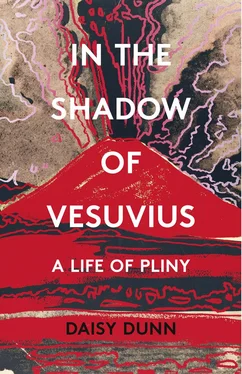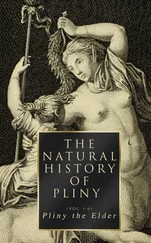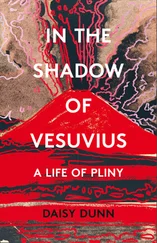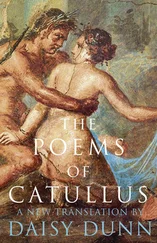The earthquake of ad 63 had been as unexpected in its timing as it had in its force. Striking on 5 February, when Pliny the Younger was little more than a year old, it made a mockery of the ancient belief that earthquakes never happen in winter. 27Theories put forward over the past 600 years for the cause of earthquakes ranged from wrathful gods to the movement of water beneath the earth and activity of fire or air. 28Pliny the Elder, for his part, subscribed to a theory of ‘opposing winds’. 29He believed that the earth and all things upon it were full of life-giving breath; that winds lurked deep beneath the ground in even the darkest hollows and ravines. Left alone, these winds were quite content within their burrows. They would make room for any fresh air that tried to insinuate its way into their caverns by leaving through chinks in the earth. 30Strato of Lampsacus, a philosopher from the school of Aristotle, had discovered that hot and cold repel one another. The winds beneath the earth would do all they could to recede from the cool, incoming air. If they could find no chinks through which to escape, however, and air continued to filter in, then a mighty struggle would ensue. It was in the midst of this battle between winds that the earth burst open to relieve the pressure mounting inside. Neither Pliny the Elder nor anyone else yet knew of the existence of tectonic plates, but his theory showed an understanding of the role that opposing forces play in triggering earthquakes.
The winds theory even partially accounted for what happened next. It was rightly presumed that the sheep that died in AD 63 did so as a result of bowing their heads so close to the earth from which gases such as carbon dioxide and sulphur were now emanating. The death of livestock is a common occurrence in volcanic regions. In the spring of 2015, over five thousand sheep died in Iceland as a result of intoxication by volcanic sulphur. Humans hold their heads sufficiently high to inhale the poison in smaller doses. Their heady confusion tends to pass. But what no one realised in AD 63 was that this earthquake and gaseous release was evidence not of winds moving beneath the earth but of magma rising within Vesuvius. Earthquakes had continued to plague southern Italy over the next sixteen years of the younger Pliny’s life as – slowly – the volcano began to wake.
As the earthquakes started to intensify across the Bay of Naples, buildings seemed both to be swaying on their foundations and collapsing from their debris-laden roofs. Pliny the Elder remained sufficiently rational to realise that to stay inside, while the earth shook and the sky fell in, would be fatal. He, Pomponianus and the other men and women in the house at Stabiae gathered up pillows, strapped them to their heads, and ventured out into the darkness. Pumice is light and porous – formed, as it is, when gas bubbles expand and burst inside the rising magma, which then solidifies and rapidly cools – but a large piece of rock might easily have felled them. 31
Back in Misenum, Pliny and his mother had made a similar decision. Pliny had gone to bed early only to be woken from a short sleep. Although pumice and ash were yet to fall here, the tremors had become so strong that objects and furniture were ‘not only being moved, but turned over’. 32Fearing accident or worse, they went outside and sat on a terrace that overlooked the sea. On the previous day Pliny had been too absorbed by his work to accompany his uncle out of Misenum. On this night, being absorbed by his work might have been – might yet be – his salvation. Summoning a slave to bring him Livy’s Ab urbe condita , a recondite history of Rome, Pliny resumed his note-taking. As he read about the foundation and development of Rome and its people – and as the earth continued to shake – Pliny focused solely on the work in hand. With retrospect he asked himself whether this was not an imprudent thing to have done (he was sufficiently circumspect to realise how he must have looked – to be scribbling while masonry was crashing to the ground), but in his heart he never doubted the wisdom of his act. He was doing precisely what he imagined his uncle would be doing, wherever he was.
Morning was now rising over Stabiae, but it was unlike any morning the people had known. It was like night, only ‘blacker and denser than all the nights there have ever been’. 33It was then that Pliny the Elder took a torch and made his way to the shore to see whether there was any chance of escape. The sea was wild. The wind was against them. And so he lay down on a cloth on the beach. He called out once, then a second time, for some cold water. He drank. Then something happened.
Fresh flames appeared and with them ‘the smell of sulphur that suggested there were more flames to come’. The people of Stabiae fled, among them Pliny the Elder’s companions. They had probably sensed the onrush of a nuée ardente – an avalanche-like ‘burning cloud’ of ash, gas and rock. 34The pine-tree cloud that Pliny and his family had witnessed from Misenum on the previous day had now collapsed into itself, too dense to be supported on its trunk any longer. 35Released from this collapse, a series of nuées ardentes had begun to sweep Campania at a minimum of a hundred kilometres an hour, making debris of whatever lay in their path.
Neither Pliny nor his uncle knew that deadly surges had already overwhelmed the town of Herculaneum. Pliny, sitting with his mother at Misenum, and his uncle, lying on a beach at Stabiae, were comparatively distant from the volcano. Stabiae lay sixteen kilometres to its south-east; Herculaneum, just seven kilometres to its south-west. Although Herculaneum had experienced little pumice-fall owing to the direction of the wind, the earthquakes had been catastrophic. In a bid to take cover, hundreds of its residents had made their way to the shore where a series of arched vaults, probably boat stores, was set back from the coast. Each vault was barely three metres wide by four metres deep. Those who could not fit inside one or reach their shelter in time – many men ceded their places to women and children – remained exposed on the coast.
The people of Herculaneum saw the avalanche coming. Huddled beneath the arches and spread out over the beach, they clung to each other. They were entirely helpless. As floods of volcanic matter hurtled towards them, they died upon impact with its heat. In its second stage, a nuée ardente produces pyroclastic flow, a current of magma and gas of around 400 degrees Celsius. Struck by a series of volcanic surges and flows, Herculaneum was buried deep beneath the layers of debris. The arches under which its inhabitants lay became their funeral vaults, shrouding their remains for the next two thousand years.
The panicking crowds at Stabiae were now witnessing what was probably the last of six pyroclastic surges . Two had already struck Herculaneum, a third hit Pompeii, a fourth overwhelmed any Pompeians who remained, and the fifth buried their city. 36Roused from his blanket on the beach, Pliny the Elder got up, leaning on two slaves for support. He managed to stand, but then he fell, defeated. fn2
Pliny later reasoned that his uncle died because the thick fumes and air had obstructed his fragile airways. He was probably right. The surge cloud from a nuée ardente is low in oxygen and would have filled his lungs with ash, asphyxiating him. 37When his body was discovered a few days later, it was said by whoever found and reported it to be intact and unharmed, with the look more of sleep than of death. The body of a victim of thermal shock does not look peaceful. It is rigid, the hands typically clenched like a boxer’s, the result of tendons contracting in the heat. Many of the bodies later uncovered at Pompeii would show signs of thermal shock.
Читать дальше












